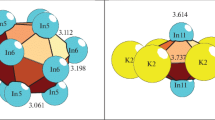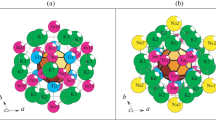Abstract
The combinatorial topological analysis and modeling of self-assembly of the K78In160-hP238 (space group P-3m1, a = b = 17.211, c = 28.888 Å, V = 7410 Å3) and K8In11-hR114 (space group R-3c, a = b = 10.021 Å, c = 50.891 Å, V = 4426 Å3) crystal structures are performed by computer methods (the ToposPro software package). Icosahedra In12 (with the -3m symmetry) are the templates on which three-layer clusters K130 = 0@12(In12)@30(In12K18)@86(K20In66) with the diameter of 17 Å are formed. The two-layer cluster K66 formed on Friauf polyhedra K(K4In12) (with 3m symmetry) has a chemical composition of shells K@16(K4In12)@49(K16In33) and a diameter of 14 Å. The K130 and K66 nanoclusters are framework-forming and involved in the formation of 2D layers A and B, respectively, thus forming a three-layer B–A–B package. The In12 clusters (with the -3m symmetry), In8 hexagonal bipyramids (with the 3m symmetry), and K spacer atoms are located in the voids of the layer of the K66 clusters. The three-layer package thickness corresponds to the value of the translation vector modulus c = 28.888 Å. The framework structure is formed by linking the three-layer B–A–B packages in the [001] direction. The cluster precursor K17 = 0@In11K6 is installed for K8In11-hR114 in the form of a triangular In5 bipyramid on six faces of which In atoms are located with six bound potassium atoms. The microlayer is formed when the primary chains are bound in the (001) plane with a shift. The localization of the K spacer atoms takes place in the layer. The microframework of the structure is formed when the microlayers are bound with a shift.








Similar content being viewed by others
REFERENCES
Villars, P. and Cenzual, K., Pearson’s Crystal Data-Crystal Structure Database for Inorganic Compounds (PCDIC), Materials Park, OH: ASM Int.
Inorganic Crystal Structure Database (ICSD), Karlsruhe: Fachinformationszentrum, USA: NIST.
Brussone, G., The D13 structure type in intermetallic compounds, Acta Crystallogr., Sect. B: Struct. Crystallogr. Cryst. Chem., 1969, vol. 25, pp. 1206–1207.
Amerioun, S. and Haeussermann, U., Structure and bonding of Sr3 In11: How size and electronic effects determine structural stability of polar intermetallic compounds, Inorg. Chem., 2003, vol. 42, pp. 7782–7788.
Blase, W. and Cordier, G., Crystal structure of potassium indium (8/11), K8 In11, Z. Kristallogr., 1991, vol. 194, pp. 150–151.
Cordier, G. and Mueller, V., Crystal structure of octapotassium undecathallide, K8 Tl11, Z. Kristallogr., 1992, vol. 198, pp. 281–282.
Cordier, G. and Mueller, V., Crystal structure of octarubidium undecaindide, Rb8 In11 in the (K8In11)-type, Z. Kristallogr., 1993, vol. 203, pp. 154–155.
Cordier, G. and Mueller, V., Crystal structure of octarubidium undecathallide, Rb8 Tl11 in the (K8In11)-type, Z. Kristallogr., 1993, vol. 203, pp. 152–153.
Kaskel, S., Klem, M.T., and Corbett, J.D., Polyatomic clusters of the triel elements. Palladium-centered clusters of thallium in A8 Tl11 Pd, A = Cs, Rb, K, Inorg. Chem., 2002, vol. 41, pp. 3457–3462.
Henning, R.W. and Corbett, J.D., Cs8 Ga11, a new isolated cluster in a binary gallium compound. A family of valence analogues A8 Tr11 X: A = Cs, Rb; Tr = Ga, In, Tl; X = Cl, Br, I, Inorg. Chem., 1997, vol. 36, pp. 6045–6049.
Cordier, G. and Müller, V., Crystal structure of potassium indium (17/41), K17 In41, Z. Kristallogr., 1993, vol. 205, pp. 353–354.
Cordier, G. and Müller, V., Crystal structure of potassium indium (22 – x/39 + x) (x = 0.67), K21.33In39.67, Z. Kristallogr., 1992, vol. 198, pp. 302–303.
Lin, B. and Corbett, J.D., Synthesis and characterization of the new cluster phase K39 In80. Three K–In compounds with remarkably specific and transferable cation dispositions, Inorg. Chem., 2003, vol. 42, pp. 8768–8772.
Blatov, V.A., Shevchenko, A.P., and Proserpio, D.M., Applied topological analysis of crystal structures with the program package ToposPro, Cryst. Growth Des., 2014, vol. 14, pp. 3576–3585.
Ilyushin, G.D., Modelirovanie protsessov samoorganizatsii v kristalloobrazuyushchikh sistemakh (Modeling Self-Organization Processes in Crystal-Forming Systems), Moscow: Editorial URSS, 2003.
Ilyushin, G.D., Modeling of the self-organization processes in crystal-forming systems. Tetrahedral metal clusters and the self-assembly of crystal structures of intermetallic compounds, Crystallogr. Rep., 2017, vol. 62, pp. 670–682.
Blatov, V.A., Ilyushin, G.D., and Proserpio, D.M., New types of multishell nanoclusters with a frank-kasper polyhedral core in intermetallics, Inorg. Chem., 2011, vol. 50, pp. 5714–5724.
Ilyushin, G.D., Symmetry and topology code of the cluster self-assembly of intermetallic compounds \({\text{A}}_{{\text{2}}}^{{[{\text{16}}]}}{\text{B}}_{{\text{4}}}^{{[{\text{12}}]}}\) of the Friauf families Mg2Cu4 and Mg2Zn4, Crystallogr. Rep., 2018, vol. 63, pp. 543–552.
Ilyushin, G.D., Modeling of self-organization processes in crystal-forming systems: Symmetry and topology code for the cluster self-assembly of crystal structures of intermetallic compounds, Russ. J. Inorg. Chem., 2017, vol. 62, pp. 1730–1769.
Pankova, A.A., Akhmetshina, T.G., Blatov, V.A., and Proserpio, D.M., A collection of topological types of nanoclusters and its application to icosahedra-based intermetallics, Inorg. Chem., 2015, vol. 54, no. 13, pp. 6616–6630.
Ilyushin, G.D., Crystal chemistry of lithium intermetallic compounds: A survey, Russ. J. Inorg. Chem., 2018, vol. 63, no. 14, pp. 1786–1799.
Funding
This study was supported by the Ministry of Science and Higher Education as part of a state order for the Federal Research Centre “Crystallography and Photonics” of the Russian Academy of Sciences and the Russian Foundation for Basic Research (RFBR no. 19-02-00636).
Author information
Authors and Affiliations
Corresponding author
Ethics declarations
The authors declare that they have no conflict of interest.
Additional information
Translated by D. Marinin
Rights and permissions
About this article
Cite this article
Shevchenko, V.Y., Blatov, V.A. & Il’yushin, G.D. Cluster Self-Organization of Intermetallic Systems: K66 and K130 Clusters for the Self-Assembly of the K78In160-hP238 Crystal Structure and K17 Clusters for the Self-Assembly of the K8In11-hR114 Crystal Structure. Glass Phys Chem 47, 13–23 (2021). https://doi.org/10.1134/S1087659621010119
Received:
Revised:
Accepted:
Published:
Issue Date:
DOI: https://doi.org/10.1134/S1087659621010119




